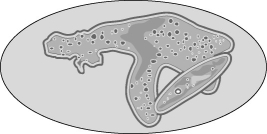You are given five test tubes, each containing an unknown protist, and your task is to read the following description and match these five protists to the correct test tube.
In test tube 1, you observe an organism feeding. Your sketch of the organism looks very similar to Figure 28.1. When light, especially red and blue light, is shone on the tubes, oxygen bubbles accumulate on the inside of test tubes 2 and 3. Chemical analysis of test tube 3 indicates the presence of substantial amounts of silica. Chemical analysis of test tube 2 indicates the presence of a chemical that is toxic to fish and humans. Microscopic analysis of organisms in test tubes 2, 4, and 5 reveals the presence of permanent, membrane-bounded sacs just under the plasma membrane. Microscopic analysis of organisms in test tube 4 reveals the presence of an apicoplast in each. Microscopic analysis of the contents in test tube 5 reveals the presence of one large nucleus and several small nuclei in each organism.

Figure 28.1
-Test tube 4 contains
Definitions:
Flat Tapers
Tapering geometry where the taper is flat, usually referring to a gradual decrease in thickness or diameter over the length of an object.
Cutting Plane
An imaginary plane where an object is assumed to be cut through to produce sectional views for technical drawings.
Theoretical
Pertains to concepts or ideas existing in theory and not necessarily by practice or actual implementation.
Countersink
A method to create a conical hole matching the angled shape of a countersink screw, allowing the head to sit flush with or below the surface of the material.
Q1: In a hypothetical situation, a certain species
Q11: The vegetative (nutritionally active)bodies of most fungi
Q24: Though plants, fungi, and prokaryotes all have
Q25: Of the following anatomical structures, which is
Q27: What important criterion was used in the
Q32: In order to properly interpret sediment cores,
Q44: Which species is probably an important contributor
Q51: Giardia's mitosome can be said to be
Q59: Suppose that a group of male pied
Q79: In septate fungi, what structures allow cytoplasmic